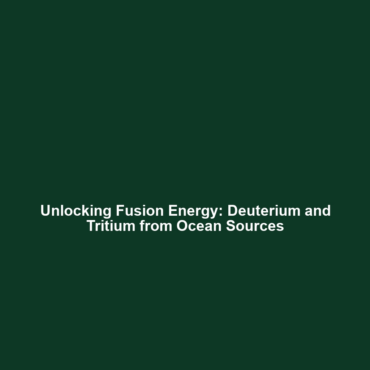Challenges in Fusion Energy: Containment of High-Temperature Plasma, Achieving Net Energy Gain, and Managing Intense Heat
Introduction
The pursuit of fusion energy represents a transformative leap in sustainable energy production. However, significant challenges remain, particularly in the containment of high-temperature plasma, achieving net energy gain (producing more energy than consumed), and effectively managing the intense heat generated during the fusion process. These hurdles are critical as they dictate the feasibility of fusion as a reliable energy source for the future and highlight the intricate physics involved in harnessing fusion power responsibly.
Key Concepts
Containment of High-Temperature Plasma
One of the primary challenges in fusion energy is the containment of high-temperature plasma. Plasma, the fourth state of matter, must be confined at temperatures exceeding millions of degrees Celsius. Techniques like magnetic confinement (used in tokamaks) and inertial confinement are pivotal in attempting to achieve stable plasma conditions.
Achieving Net Energy Gain
Achieving net energy gain is crucial; this means producing more energy from fusion reactions than is consumed in the process. Current experimental reactors strive to overcome this barrier, thus making advancements in energy sustainability critical.
Heat Management
The intense heat generated during fusion reactions poses another significant barrier. Advanced materials must be developed to withstand extreme temperatures while maintaining structural integrity, shaping the future landscape of fusion technology.
Applications and Real-World Uses
The implications of overcoming the challenges associated with high-temperature plasma containment and achieving net energy gain are profound. Potential applications of these advancements in fusion energy include:
- Power Generation: Fusion reactors could provide clean, sustainable electricity on a large scale.
- Space Exploration: Efficient propulsion systems using fusion energy could revolutionize long-distance space travel.
- Desalination: Utilizing fusion reactors to supply heat for desalination processes can address global freshwater shortages.
Current Challenges
Despite the potential of fusion energy, several challenges continue to limit research and application:
- Maintaining stable plasma confinement under extreme conditions.
- Developing materials capable of withstanding extreme heat and neutron bombardment.
- Achieving and maintaining the necessary conditions for net energy gain.
Future Research and Innovations
Ongoing research aims to address these challenges through innovative approaches. For instance, advancements in superconducting magnets are paving the way for better plasma confinement methods. Additionally, the exploration of new materials that can endure the heat and radiation of a fusion reactor is underway. These research avenues hold the promise of overcoming existing limitations and propelling fusion energy toward practical reality.
Conclusion
In summary, containment of high-temperature plasma, achieving net energy gain, and managing intense heat remain significant challenges in the realm of fusion energy. Addressing these challenges is essential for the successful implementation of fusion technology as a reliable energy source. To further explore the future of fusion energy and potential solutions, visit our related articles on advancements in fusion technology and innovative energy solutions.









